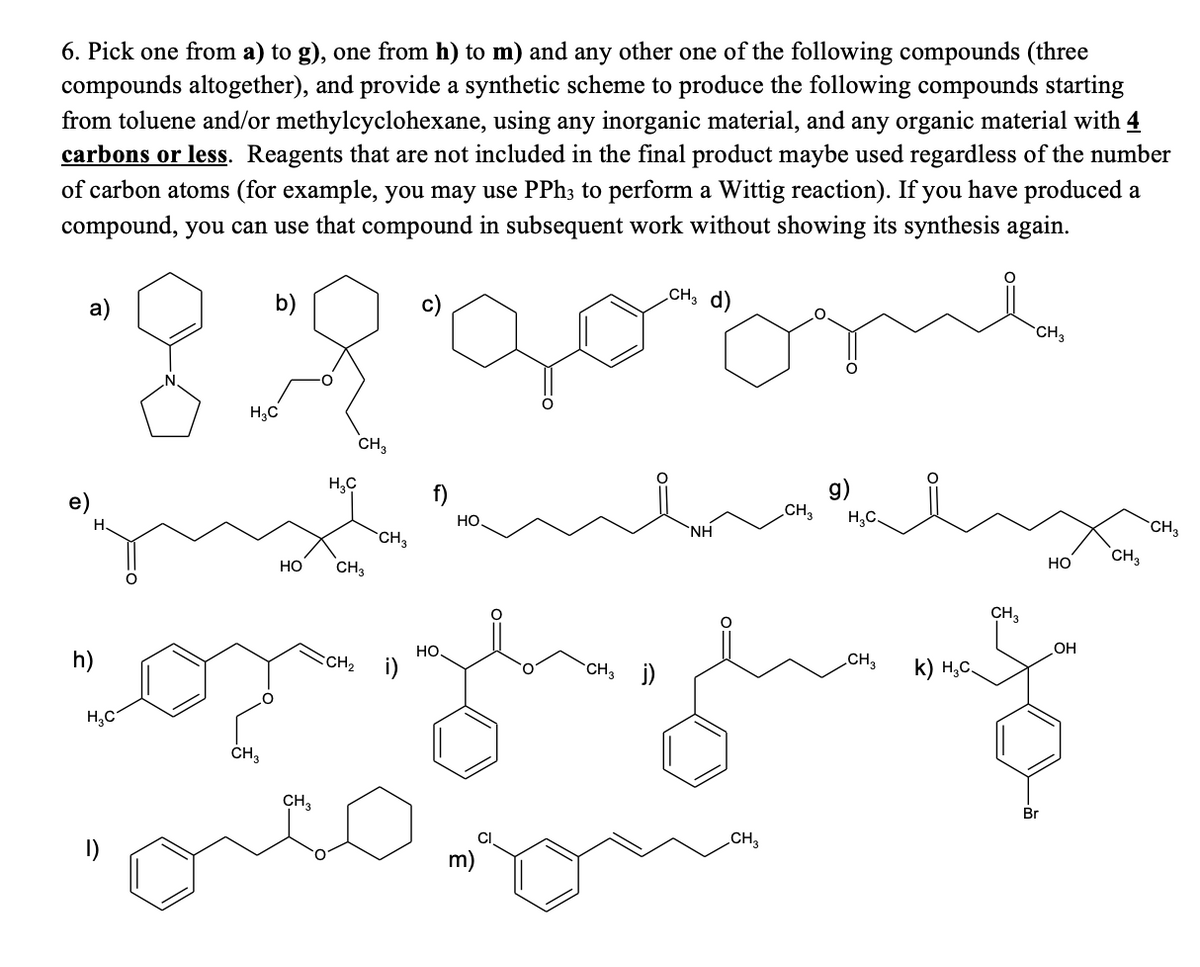6. Pick one from a) to g), one from h) to m) and any other one of the following compounds (three compounds altogether), and provide a synthetic scheme to produce the following compounds starting from toluene and/or methylcyclohexane, using any inorganic material, and any organic material with 4 carbons or less. Reagents that are not included in the final product maybe used regardless of the number of carbon atoms (for example, you may use PPh3 to perform a Wittig reaction). If you have produced a compound, you can use that compound in subsequent work without showing its synthesis again. a) b) CH3 d) CH3 gula g) HO h) H₂C H₂C CH₂ HO CH₂ H₂C CH3 CH3 CH3 CH₂ i) HO НО. m) CH3 j) NH CH3 CH3 H₂C. CH3 k) H₂C_ CH3 Br OH CH3 CH3
6. Pick one from a) to g), one from h) to m) and any other one of the following compounds (three compounds altogether), and provide a synthetic scheme to produce the following compounds starting from toluene and/or methylcyclohexane, using any inorganic material, and any organic material with 4 carbons or less. Reagents that are not included in the final product maybe used regardless of the number of carbon atoms (for example, you may use PPh3 to perform a Wittig reaction). If you have produced a compound, you can use that compound in subsequent work without showing its synthesis again. a) b) CH3 d) CH3 gula g) HO h) H₂C H₂C CH₂ HO CH₂ H₂C CH3 CH3 CH3 CH₂ i) HO НО. m) CH3 j) NH CH3 CH3 H₂C. CH3 k) H₂C_ CH3 Br OH CH3 CH3
Organic Chemistry: A Guided Inquiry
2nd Edition
ISBN:9780618974122
Author:Andrei Straumanis
Publisher:Andrei Straumanis
Chapter14: Elimination
Section: Chapter Questions
Problem 30E
Related questions
Question

Transcribed Image Text:6. Pick one from a) to g), one from h) to m) and any other one of the following compounds (three
compounds altogether), and provide a synthetic scheme to produce the following compounds starting
from toluene and/or methylcyclohexane, using any inorganic material, and any organic material with 4
carbons or less. Reagents that are not included in the final product maybe used regardless of the number
of carbon atoms (for example, you may use PPh3 to perform a Wittig reaction). If you have produced a
compound, you can use that compound in subsequent work without showing its synthesis again.
CH3 d)
a)
b)
CH3
8:2
H₂C
CH3
H₂C
g)
H
h)
H₂C
CH3
HO
CH3
CH3
CH3
CH₂ i)
f)
HO
HO
o=
CH3 j)
ΝΗ
CH3
CH3
H₂C.
CH3
k) H₂C.
CH3
Br
HO
OH
CH3
CH 3
Expert Solution
This question has been solved!
Explore an expertly crafted, step-by-step solution for a thorough understanding of key concepts.
This is a popular solution!
Trending now
This is a popular solution!
Step by step
Solved in 2 steps with 1 images

Knowledge Booster
Learn more about
Need a deep-dive on the concept behind this application? Look no further. Learn more about this topic, chemistry and related others by exploring similar questions and additional content below.Recommended textbooks for you

Organic Chemistry: A Guided Inquiry
Chemistry
ISBN:
9780618974122
Author:
Andrei Straumanis
Publisher:
Cengage Learning

Organic Chemistry
Chemistry
ISBN:
9781305580350
Author:
William H. Brown, Brent L. Iverson, Eric Anslyn, Christopher S. Foote
Publisher:
Cengage Learning

Organic Chemistry: A Guided Inquiry
Chemistry
ISBN:
9780618974122
Author:
Andrei Straumanis
Publisher:
Cengage Learning

Organic Chemistry
Chemistry
ISBN:
9781305580350
Author:
William H. Brown, Brent L. Iverson, Eric Anslyn, Christopher S. Foote
Publisher:
Cengage Learning